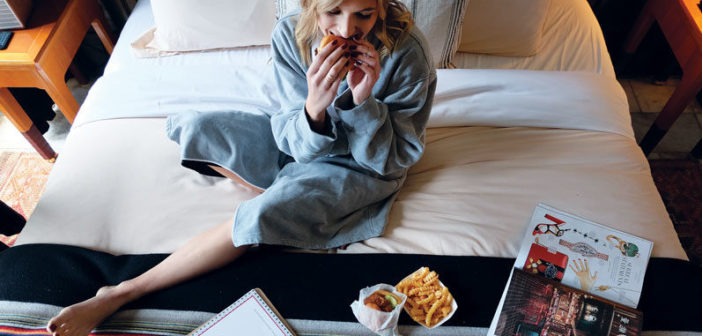NATIONAL REPORT—In 2013, the New York Hilton Midtown became the talk of the NYU International Hospitality Industry Investment Conference with the news that it was stopping room service. While the casual dining concept it later implemented, Herb N’ Kitchen, does offer room delivery during breakfast and dinner, in recent years, amid declining in-room dining revenues, hotels have looked to many different solutions to give guests what they want—grab-and-go markets, casual dining eateries with to-go boxes that guests can bring to their rooms, and a greater focus on hotel restaurants that give guests a taste of local culture. Now, many in the industry are turning to in-room dining choices that give guests a mix of what they expect at home with unique, local cuisine.
“Today’s travelers do not want the traditional three-meal-a-day all-purpose hotel restaurant,” said Robert Mandelbaum, director of research information services, CBRE Hotels’ Americas Research. “They want new concepts that service local foods, healthy foods, and provide a unique experience. This has driven new F&B concepts [and has]also contributed to the declines in revenue we have seen from the in-room F&B revenue sources: room service and minibar.”
According to the company, in 2016, food & beverage in-room dining accounted for only 2.8% of total department revenue, and the average annual change of in-room dining revenue from 2010 to 2016 was a 1.3% decrease—making it, along with the minibar, the only area of the F&B department to experience a decline.
“Historically, hotels have tolerated losses within their restaurants since it was believed that hotels needed to have a restaurant in order to attract business travelers,” Mandelbaum said. “Owners will no longer tolerate such losses. The new Grab-and-Go markets in the lobbies, ‘bagged’ room service, and offering local restaurant deliveries to replace room service all help to reduce costs, as well as satisfy guests.”
“What we hear most is that travelers simply want more options. This includes the freedom to choose from a variety of different cuisines at times convenient for them,” said Sandra Cordova Micek, SVP of Hyatt global brands. “We recognize that there are several different types of travelers out there, all with their own sets of needs and priorities, and we are constantly refining our hotel brands to provide choices.”
Last year, Hyatt Centric piloted a partnership with Grubhub, an online and mobile food ordering company, with three hotels; now, the brand is expanding the program nationwide to nine hotels. Part of the brand’s Restaurant To Go program—which includes a full-service, in-room dining offering with multiple options, including on-property restaurant delivery, 24/7 Express menu delivery and the new Grubhub program—Micek noted this gives guests the choices that they desire.
“If they choose to explore the local cuisine from the comfort of their own room, we want to be the brand that allows travelers to do just that,” she said.
The decision to expand the program was based on guest feedback. “Based on customer surveys, most rated the service a 9/10 or 10/10, with many appreciating the fact they could sample authentic, local cuisine with added convenience and ease,” Micek said.
Micek noted that the program gives guests the best of both worlds: access to the “new and authentic travel experiences” they crave via dining recommendations curated by hotel staffers—who are locals themselves—by way of a platform guests are used to. “Guests from across the nation are familiar and comfortable with Grubhub,” she said.
The Chicago Athletic Association hotel had a similar idea in mind with its in-room dining offering. In addition to its 24/7 in-room dining menu, the hotel offers food from the Shake Shack located on its first floor as an in-room option between 3 p.m. and 10:30 p.m.
Michael Mason, director of restaurants & bars for the property, noted that it’s an interesting time for in-room dining. “There are a lot of hotels who are killing it altogether, and others are leaning in as hard as we can to give something special and unique,” he said. When it came to the property’s F&B offering, the hotel looked to the venue’s former occupation as an athletic club. “We wanted to do something that would fit with the aesthetic of the hotel; which is an old former athletic club,” he said.
But while the hotel wanted to offer something distinctively local—and healthy—for guests, it also wanted to offer comfort food. “Some people need different things when they’re staying with us, and we try to balance as many healthy options as possible with the staples of what people may want after they’ve been out for a night drinking,” Mason said.
Enter Shake Shack—a nationwide chain known for cheeseburgers and fries, but also for incorporating local ingredients into its menu. “We thought it would be really great for this to be the only place in the world where you can get Shake Shack delivered to your bed hot off the grill,” Mason said. “We wanted to innovate and have something where we would be able to say, ‘This is a unique thing that you can only get here.’”
Feedback from guests has been positive. “People come specifically for it,” Mason said.
Similarly, the hotel has opened Fairgrounds, a coffee shop that serves various roasters from across the country. Guests have the option of sampling an unknown coffee or a hometown staple—or they can get a flight that includes a mix. Mason said the next step is figuring out “how to set something up to get this to our in-room dining guests and how to use it in event spaces.”
Of course, in-room dining isn’t just about what meals guests can order from the property. For extended-stay guests, it’s about what they can cook in their rooms. Similar to Hyatt Centric, Hawthorn Suites by Wyndham recently piloted a program with leading online grocers Peapod and Instacart at eight properties to give guests the ability to order food via services they’re used to. In addition to their most-wanted grocery items, guests can also order ingredients for Homemade @ Hawthorn recipes, the brand’s in-room, chef-driven cooking program serving up seasonal recipes.
Larry Hambro, VP, brand operations, Hawthorn Suites by Wyndham, noted, “When you’re on the road for weeks or months at a time, a hotel stay isn’t a business trip or a vacation—it’s life. Convenience is key, and we’re always finding ways to help travelers easily stick to their routines so they feel more at home. With this in mind, it was only natural to take our existing in-room cooking program, Homemade @ Hawthorn, and blend it with an easy, accessible and increasingly familiar method for long-term guests to get groceries without hunting for the nearest store.”
He noted that more and more Americans are shopping for groceries online—nearly 25% of American families and one out of every 10 millennials and Gen Xers use these services. “By recognizing and leveraging the popularity and ease of this trend, we’re helping our guests live on the road like they live at home. Doing this with industry leaders like Peapod and Instacart tells travelers how seriously we take this—we want to work with the best in the field so our guests feel that much more confident about using the service,” he said.
“It’s also a wonderful way to provide our guests with the ingredients for our signature recipes, giving them the power of selection and familiarity, along with the convenience of delivery,” he said.
Mandelbaum noted that in-room dining revenue, along with minibar sales, have yet to recover to their pre-recession levels at the average U.S. hotel that offers these services, and the lower price points of new room service menus as well as the loss of revenue from outsourcing to local restaurants—hotels still receive a commission—means it’s unlikely to get back to those levels in the immediate future. However, he said, “Given the cost savings, hotels may have a better opportunity to make a profit in this area going forward.” HB


